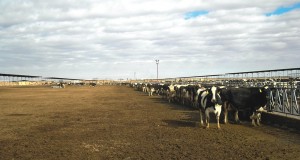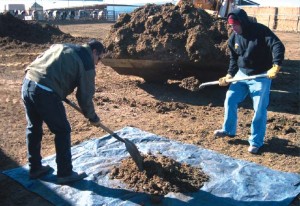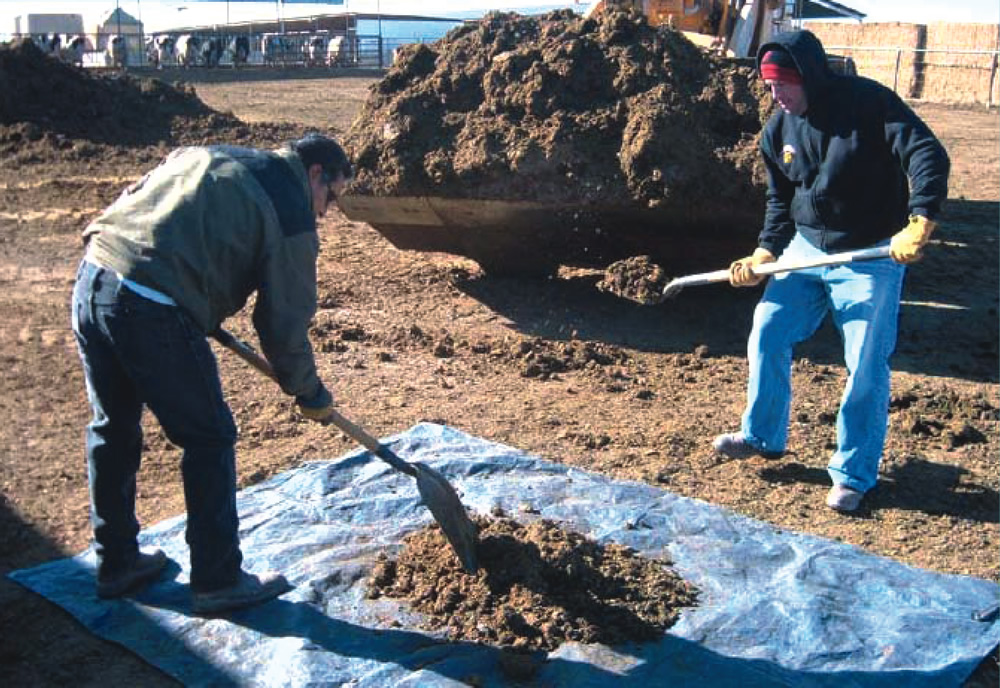Dry lot dairies have replaced feedlots in the Pecos Valley in New Mexico. A recent study evaluated the feasibility of anaerobically digesting manure from these operations.
Diane Greer
BioCycle February 2012, Vol. 53, No. 2, p. 46
 Dry lot dairies, the predominant type in New Mexico, face unique waste management challenges. The hot arid climate, scarce water resources and waste collection methods limit technology choices for treating manure.
Dry lot dairies, the predominant type in New Mexico, face unique waste management challenges. The hot arid climate, scarce water resources and waste collection methods limit technology choices for treating manure.
Six years ago Chaves County, New Mexico, dry lot dairy producers formed the Pecos Valley Biomass Cooperative, Inc. (PVBC) to find solutions that address environmental issues while producing energy from dairy manure. The cooperative represents 22 dairies and over 60,000 cows located within a 12-mile radius in the Pecos Valley. “The whole motivation for forming the cooperative was to look into what technologies were available to handle the very concentrated amount of manure we have here,” explains Gerry Greathouse, one of the dairymen leading the PVBC project.
The Pecos Valley, running along the Pecos River south of Roswell to Artesia, New Mexico, supports a thriving agricultural community. Crop farming dates back over 100 years. Feedlots moved into the valley almost 50 years ago. During the past 20 years dairies have replaced the feedlots.
Solid wastes, first from the feedlots and now the dairies, have been land applied for decades while liquid nitrogen fertilizer has been applied to area crops. “All these things have contributed to what we see in the groundwater now,” Greathouse says. Nitrogen contamination of the groundwater is the main concern in the valley, explains David Belcher, PVBC project manager. The valley is somewhat unique in that is has a recharged aquifer. This critical resource and water usage are carefully monitored.
Proper manure management is essential to preventing nitrogen contamination in the aquifer. “The problem is there are way too many solids for the amount of farm ground,” Greathouse notes. “This whole project is about turning nutrients [in the manure] into value added products that can be exported out of the area.”
PVBC recently completed a study analyzing its waste streams to determine the most appropriate and efficient management technologies. Based on the results, an economic evaluation is underway to evaluate the feasibility of implementing a centralized anaerobic digestion system to generate electricity and value-added products from dairy manure.
Waste Stream Analysis
Dry lot dairies are built much like feedlots. Cows are held in open corrals. Covered sheds provide shade and bedding areas. During milking operations the cows go to central milking parlors, returning to the lot to be fed until the next milking. Feeding occurs on concrete feeding aprons running along the perimeter of the corrals.
Solid wastes are typically scraped from the concrete feed apron on a daily basis (daily scrape) and from the corral weekly (weekly scrape). Collected waste is spread out to dry in the sun and then hauled to fields where it is land applied at agronomic rates as a soil amendment. Liquid waste generated in the milking parlor when cows and equipment are washed is stored in lagoons and land applied with irrigation equipment. A small amount of manure deposited by the cows in the milking parlor ends up in this waste stream, referred to as greenwater.
In 2009, PVBC received $2.37 million from the U.S. Department of Energy for an intensive technical and economic feasibility study to characterize its waste streams and then define the technology most appropriate for treating the characteristics of the manure. The project team specified sampling protocols and tests to characterize the greenwater, daily scrape and weekly scrape. Weekly scrape from the corrals accounts for 50 percent of the total waste stream. The daily scrape is 40 percent and greenwater is 10 percent.

Waste samples were collected over different time periods and from different dairies. Makeup of each sample was determined by measuring the ash, volatile solids and fixed carbon content.
Sampling Results
The sampling and data analysis summary is shown in Table 1. The analysis found a great deal of variation in the wet weight of manure collected per cow in the weekly scrape, ranging from 20-lbs/cow to 140-lbs/cow. Variations in the samples taken during different times of year were mainly due to precipitation. “We do not get a lot of precipitation in the Pecos Valley area, around 10-inches or less,” Belcher says. “But some samples were taken when some precipitation was occurring.”
The variations remained after moisture was subtracted from the samples. The difference, in most cases, is the result of the amount of inorganic material (dirt, rocks, etc.) in the sample. Inorganic material gets mixed into the manure in the open corral areas (weekly scrape) when it rains, by the cows churning the soil as they walk around the corral and by the physical process of scraping the manure off the top of caliche soil that forms the base of the corrals.
Typically the average total solids content of manure collected from free stall dairies is about 12 percent. (Most dairies in the U.S. are free stalls.) The study found that leaving the manure out in the elements for just 24 hours (daily scrape) almost doubled the solids content to 20 to 25 percent. The reduction in moisture was further exacerbated when the material was exposed to the sun and weathering for a full week. Total solids content of the weekly scrape shot up to 60 percent.
Moisture levels are a critical factor when considering the viability of anaerobic digesters to process the waste. Wastes containing high solids levels need to be mixed with substantial quantities of water before they can be digested. BMP, a 50-day test that measures the gas produced for a set amount of volatile solids, was 12 percent lower in the daily scrape compared to as excreted manure. BMP for the weekly scrape was about half that of the daily scrape.
The ash content of the daily scrape averaged 22.7 percent compared to as excreted manure that averages 15 percent. Windblown dust and cows tracking material on the concrete feed apron are the primary sources of ash in the daily scrape. The volume of ash in the weekly scrape averaged 49.7 percent. Over the course of a week the volatile solids content of the weekly scrape dropped by 50 percent compared to the as excreted manure. Reductions in volatile solids levels is due in part to the amount of inorganic material in the weekly scrape, as well as the degradation due to the sun and weathering, Belcher explains. Temperatures for six months of the year can top 100° F during the height of the day with 20 to 30-mph winds in the afternoon and extremely low humidity. “We have this very harsh environment and that is going to have an effect on the quality and quantity of volatile solids,” Belcher says.
The combustibility of the material was further analyzed by measuring the HHV (higher heating value) of the samples. The weekly scrape exhibited a higher HHV (2,146 BTU/lb) then the daily scrape. “The lower the moisture levels the higher the heat value,” he adds. “If you can dry manure to zero percent moisture the average heating value goes up to 3,686 BTU/lb. Of course any inorganics you can keep out of the material to reduce the ash content is also going to increase the heat value.” (In comparison, the heating value of cordwood is 6,200-6,300 BTU/lb.)
Study Conclusions
The data clearly shows the biogas potential, as measured by VS and BMP, of the manure decreases as the material weathers and is mixed with inorganic materials. “It becomes a question of efficiency and cost effectiveness,” Belcher explains. “What our consultants and the data tells us is that is just does not make sense to take a material that is 50 percent moisture, add water to it in a place where water is scarce and try to digest it.”
Collecting the weekly scrape more frequently to prevent drying and degradation is not viable because of material handling and efficiency issues. “Even if the material could be collected more frequently it would still contain high levels of inorganic material,” he notes. “The material you can collect quickly on a daily basis off the feed apron [daily scrape] is much cleaner and still has good degradation potential. So that’s what we are focusing on in the Pecos Valley, looking at digestion of that material mixed with greenwater.”
While the weekly scrape is notsuitable for digestion it does have some combustion potential or it could be collected for composting. PVBC is currently considering gasification of the weekly scrape. “One boiler company has looked at the material and the data and feels that it is viable,” Belcher says. Consultants have rendered similar opinions. The particular technology under consideration, a fluidized sand bed gasification system, will accept a lot of inorganic material.
Next Steps
PVBC expects to complete the conceptual design and economic analysis of a community digester system processing the daily scrape and greenwater in early 2012. A community digester makes more sense than digesters on each dairy since only 50 percent of a dry lot dairy’s manure can be digested. “You really need more than one dairy to make things work,” Greathouse says. An investor group and technology providers are working with PVBC on the project.
Codigesting other wastes in the system to increase biogas production and improve project economics is not an option. “There is limited substrate availability,” Belcher says. “There is a lot of agricultural production [in the Valley] but not a lot of agricultural processing. Another major challenge is the logistics and economics of transporting the waste materials to the community digester on a daily basis. “That will be quite a feat and is going to be expensive,” Greathouse says. New Mexico recently approved a tax credit subsidizing the hauling of dairy biomass, which can offset some of those costs. The credit will pay $5/wet ton to help offset manure hauling and handling costs. Total payments statewide are capped at $5 million/year.
If the digester project moves forward, biogas will be used to produce electricity sold to the grid. Negotiations are underway with a local utility to develop a power purchase agreement (PPA) that will satisfy the requirements of the New Mexico RPS standard. Pricing of the PPA will require the approval of the New Mexico Public Regulatory Commission.
Effluent from the digester will be separated into solid and liquid components. Under a proposed agreement the investors will market the material. The liquid portion will need further treatment to reduce nutrients, specifically nitrogen, to satisfy compliance requirements and get land applied. “Any remaining water will be used to grow forage crops,” Belcher says. “We need the water.”
Diane Greer is a Contributing Editor to BioCycle.










